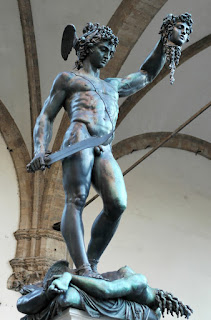Wednesday, January 13th, 2010
Loggia dei Lanzi and Subjugation
Several years ago, I sat in the Loggia dei Lanzi (Florence) and sketched some details of the statues found there. If I had thought hard about it, I might have noticed that several of the sculptures there share an interesting commonality. See if you can find the common theme:
(I recently wrote a post about Perseus here.)
 Pio Fedi, Rape of Polyxana, 1866
Pio Fedi, Rape of Polyxana, 1866
 matter which emphasizes the subjugation of women or “man’s longed-for control over woman.”1 I’ve been reading an article this week by feminist Yael Even who reveals this common theme in the loggia space. It’s quite fascinating. The most interesting thing to me, though, is that another sculpture used to be located here. Donatello’s Judith and Holofernes (1456-57, shown right) was the first sculpture placed in the Piazza della Signoria (where the Loggia dei Lanzi is located). However, over time, Donatello’s sculpture was shuffled around different sections of the loggia and elsewhere. In 1980, the sculpture was eventually moved (concealed?) to the inside of the Palazzo Vecchio. Yael Even points out that the difficulty with placing this sculpture has to do with the subject matter – instead of emphasizing the subjugation of women, Donatello’s sculpture depicts a woman killing a man.1
matter which emphasizes the subjugation of women or “man’s longed-for control over woman.”1 I’ve been reading an article this week by feminist Yael Even who reveals this common theme in the loggia space. It’s quite fascinating. The most interesting thing to me, though, is that another sculpture used to be located here. Donatello’s Judith and Holofernes (1456-57, shown right) was the first sculpture placed in the Piazza della Signoria (where the Loggia dei Lanzi is located). However, over time, Donatello’s sculpture was shuffled around different sections of the loggia and elsewhere. In 1980, the sculpture was eventually moved (concealed?) to the inside of the Palazzo Vecchio. Yael Even points out that the difficulty with placing this sculpture has to do with the subject matter – instead of emphasizing the subjugation of women, Donatello’s sculpture depicts a woman killing a man.1
When looking at all the depictions of female subjugation in the loggia, it’s no wonder that this sculpture sat uneasily (literally!) with the Florentines. After all, wouldn’t it make a (male) viewer uncomfortable to know that women can retaliate?
I really recommend that you read Even’s article.
1 Yael Even, “The Loggia dei Lanzi: A Showcase of Female Subjugation,” in Woman’s Art Journal 12, no. 1 (1991): 10.
2 Ibid.

Aw, I thought the answer was that they all showed people stepping on other people. 😛
Funnily enough, I just finished reading a book about Donatello.
Oh, how I'd love to go the things you written about in person!
For the time being, I must live through your stories.
Where's this article? Was I totally blind and just missed a link in the post??
Ha ha! I do like your answer, heidenkind. 🙂 I didn't think about that commonality, but it's true (and really noticeable when you see all three statues together in the same post).
(Is the Donatello book for your Art History Reading Challenge? I'm excited to hear about it.)
e, I didn't add a link to the post. It's available through some academic sites like JSTOR, though. The article information is in the footnote for this post.
Came across your blog through "Art and Architecture, mainly" and am enjoying it enormously. I missed buying a picture of Judith & Holofernes by the Belgian artist Arthur Greuell:
http://corcol.blogspot.com/search/label/Arthur%20Greuell
Interestingly, (in reference to your post on Caravaggio, his Judith appears to be right handed, (at least decapitating Holfernes with the sword in her right hand).
Thanks for your comment, columnist! Welcome to my blog. And thanks for sending a link to your own blog – I am enjoying it very much.
That Greuell painting of Judith and Holofernes has a very interesting composition. I've never seen it before. I'm sure you were sorry to be outbid!
Yeah, this is pretty much accepted fact, I generally teach this material to undergrads. Also you may have noticed that almost all the statues in the piazza are threatening to chop your head off if you don't obey one government or the other!
I am linking this post to one I'm writing that will come out tomorrow on TuscanyArts, the arts blog I write for the Regione Toscana. It's a one-day itinerary in Florence – I know, everyone should always spend a much longer time here… I for one came and stayed 😉
As I can't log in with name/url, here's the link to that blog, sorry… http://arts.allthingstuscany.com
ps – i've been enjoying your blog for ages!
Thanks for your comment and kind words, Alexandra! I'll look for your forthcoming post. The TuscanyArts blog looks like it could be a great resource for me, too, especially since I'm going to teach an Italian Renaissance class during the next school year. It will be nice to keep up with the exhibitions and ongoings in the Tuscany area. Thanks for leaving me the link.
And you also bring up a good point about the head-chopping and the government. Pretty good political propaganda, huh?